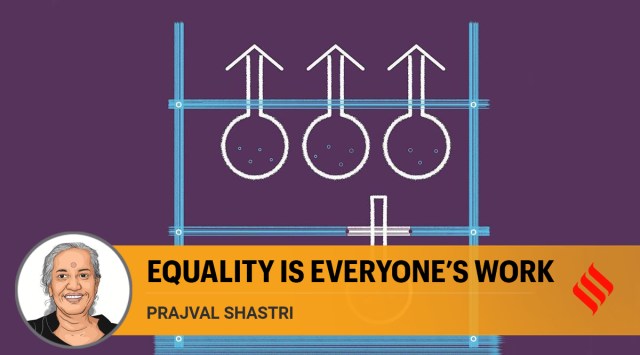- India
- International
Women-only chairs do not address root cause of gender disparity in science and technology
Prajval Shastri writes: Gender disparity is an outcome of a flawed meritocracy and is everybody’s responsibility, not just that of women chairs, to fix
 It is still often assumed by men, and women, that women are the primary caregivers and, therefore, liable to compromise their professional responsibilities, while overlooking what their productivity record actually shows. (Illustration by C R Sasikumar)
It is still often assumed by men, and women, that women are the primary caregivers and, therefore, liable to compromise their professional responsibilities, while overlooking what their productivity record actually shows. (Illustration by C R Sasikumar)On National Science Day 2020, which was dedicated to “women scientists”, Women and Child Development Minister Smriti Irani announced that 11 women scientists would be honoured with national chairs (professorships) named after “historical women scientists” [sic]. Last week, IIT Bombay announced its own “women-only” chair, named after donor alum Amit Dixit. “…we firmly believe that a diverse and inclusive workforce builds better businesses,” Dixit said. While these announcements are well-intentioned moves to address the long-standing and vexed problem of gender disparity in science and technology, will they really tackle the root cause?
That there is gender disparity is incontrovertible. Women constitute nearly 50 per cent of science PhDs employed in Indian higher education, but granular statistics, from physics, engineering and the industrial workforce show a large gender gap that widens further at the higher echelons. IIT Bombay is no exception. About 680 faculty span mostly engineering and science, of which nearly 60 hold prestigious “chairs” but only 14 per cent of the faculty and 9 per cent of the chairs are women, even as 25 per cent of the chairs remain unfilled.
A popular explanation for the disparity is that discriminatory familial responsibilities weigh women down. Studies that have measured productivity across gender, however, find no deficit among women scientists in Indian institutions. Moreover, the disparity differs across academic disciplines. So, it is not the whole story.
Furthermore, these studies found that despite similar scientific productivity, women scientists tended to occupy lower rungs of the institutional hierarchy. Indeed, a drop in the selected women-fraction compared to that of the pool (for example, 9 per cent women chairs compared to 15 per cent women faculty in IIT Bombay) is a hallmark of the discrimination in the process.
IIT Bombay has quite a gendered legacy to overcome, and the churning commenced a long time ago. In my time there, circa 1977, the administration had directed departments to not recruit women in post-graduate direct recruitments because there was no room in the “ladies” hostel. This hostel was built far from other students’ hostels and the gym complex. A 10pm curfew obstructed our access to the library and laboratories. The new swimming pool, at first, prevented our access to the regular students’ slots, banishing us to the weekly “women only” slot. We pushed back, however, to craft our own learning environment. We changed the gender-marked name “Ladies Hostel” to the more generic “Hostel 10” by vote, unilaterally abandoned the curfew, and obtained equitable access to the pool. Remarkably, we got acquiescence from the authorities — which was commendable — but faced an ugly backlash from many of our male peers.

Systemic genderisation plays out in multiple ways. It is still often assumed by men, and women, that women are the primary caregivers and, therefore, liable to compromise their professional responsibilities, while overlooking what their productivity record actually shows. It is still considered okay to judge the parental or life-partner status of a woman scientist while deciding to hire her or give her a leadership position, overlooking her merit. It is still a common hidden norm that women spouses of already hired faculty, however meritorious, will not be hired. Gender-based harassment is, of course, rampant.
The way forward is to dissolve the systemic barriers to equity. Several pathways to do this in institutions of higher learning are listed in the Hyderabad Charter for Gender Equity in Physics drafted by the Gender in Physics Working Group of the Indian Physics Association, of which this author was founder-chair.
First, make diversity an imperative not just because it “…builds better businesses,” but because it is the right and just thing to do. Second, acknowledge that gender discrimination, mostly unconscious, reigns within. So, stop women-only training workshops to “fix the women” and instead gender-sensitise all faculty and management, because all of us, regardless of gender, are raised to accept sexist thought and action. Also invest in diversity experts (not necessarily women) to be observers on all hiring, assessment and conference planning committees. Third, involve social scientists, so that interventions are grounded in evidence. Indeed, eminent IIT Bombay professors Pravina Parikh and Suhas Sukhatme, decades ago, involved their sociologist colleague Indira Mahadevan when recommending, inter alia, JEE fee-waivers for women. On the other hand, the IIT Joint Admissions Board committee to increase gender diversity among JEE rankers did not have a single social scientist and ended up not addressing the elephant in the room. Fourth, addressing disparity should be everybody’s responsibility. It is all too common to regard it the exclusive responsibility of women to hire more women, to invite women to conferences and edit books, and even to mentor young women. This notion amounts to an abdication of responsibility by the men.
Indeed, the current faculty who are from my IIT cohort are exposed to global debates on systemic gender discrimination. So, it is about time that all faculty are impelled to make this their cause, rather than leave it to, for example, the “voluntary groups” in IIT Bombay that the new Dixit chair is mandated to lead.
Gender disparity is an outcome of a flawed meritocracy and is everybody’s responsibility, not just that of women chairs, to fix.
This article first appeared in the print edition on June 16, 2021 under the title ‘Equality is everyone’s work’. The writer is an astrophysicist from Bengaluru and an alum of IIT Bombay. The views expressed are personal
EXPRESS OPINION
More Explained
Apr 25: Latest News
- 01
- 02
- 03
- 04
- 05












































